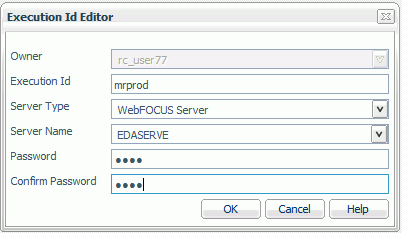
How to: |
An Execution ID is a valid user ID that is used to run a schedule on a specified server. When an Execution ID is created, changed, or deleted on a server, it must also be created, changed, or deleted in the ReportCaster Repository tables using ReportCaster. Similarly, when the password for an Execution ID is changed on the server, the password for that Execution ID must also be changed in the ReportCaster Repository tables. Exceptions are when Execution credentials are Trusted.
To view a list of execution IDs, in the ReportCaster Development interface, select the Execution Ids tab. The following image is an example of the Execution Ids tab.

From this tab, you can:
Note: When you create, change, or delete an Execution ID, the ReportCaster Repository tables are updated so that they are synchronized with the specified server. However, the credentials of the user ID on the server itself remain unchanged.
The Execution Id Editor opens, as shown in the following image.

The Execution Id Editor opens, as shown in the following image.

Changing the password using ReportCaster does not change the password on the specified server.
After the Execution ID is deleted, a scheduled job that requires this Execution ID on the specified server is not run unless the schedule is modified to use a valid Execution ID. If you modify the Execution credentials for a single schedule that specifies the deleted Execution ID, ReportCaster makes this modification for all schedules that specify the deleted Execution ID.
| WebFOCUS |